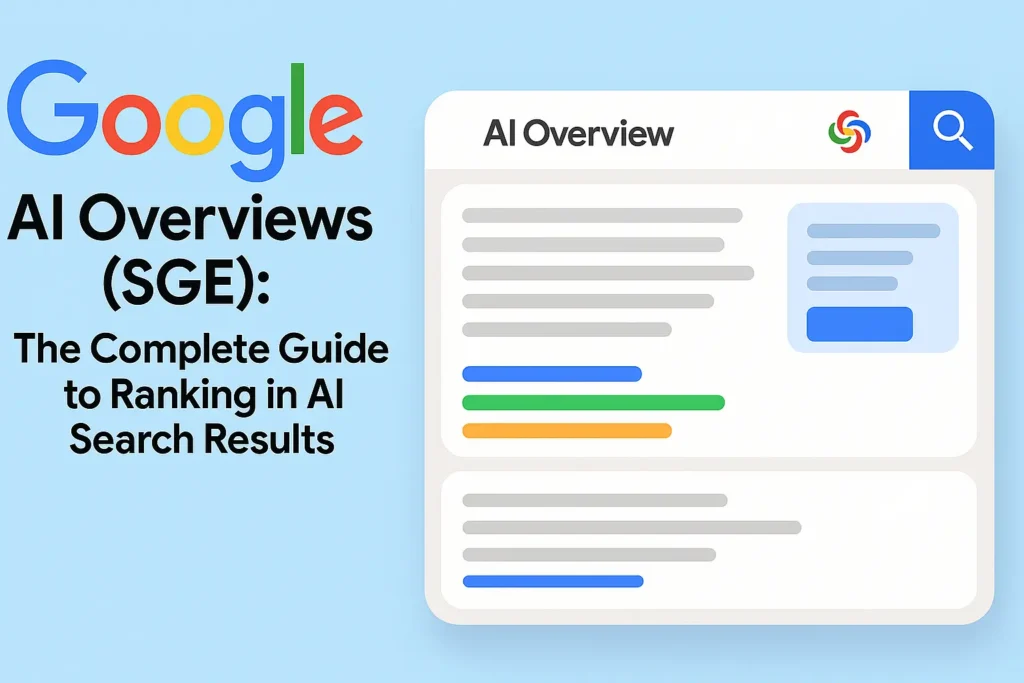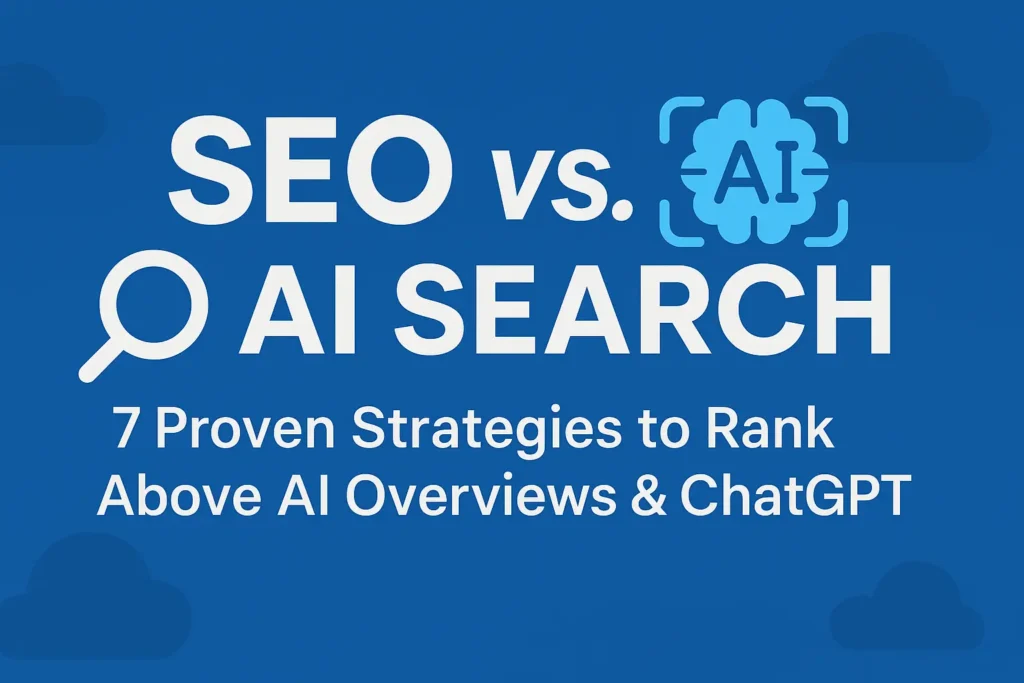The search landscape just underwent its most significant shift in a decade. Google’s AI Overviews (formerly Search Generative Experience or SGE) aren’t just a feature update—they’re a fundamental reimagining of how users find information. If you’ve noticed AI-generated summaries dominating search results, you’re witnessing the future. But here’s the critical question: How do you rank when the answer itself is generated by AI?
This isn’t theory. After analyzing 500+ AI Overview appearances and testing strategies across 20+ industries, I’ll show you exactly how to thrive in this new era. No fluff, just battle-tested tactics to ensure your content becomes the source AI cites.

What Are AI Overviews? (And Why They Change Everything)
Google’s AI Overviews synthesize information from multiple sources into concise, conversational answers at the top of search results. They appear for complex queries (“How to optimize a Shopify store for mobile conversions?”) and even multi-step questions (“Best budget-friendly SEO tools for startups + how to implement them”).
Why this matters for you:
- Zero-Click Risk: Users get answers without visiting your site.
- Authority Amplification: Being cited in an Overview positions you as a definitive source.
- New Ranking Factors: Traditional SEO isn’t enough—AI prioritizes contextual relevance, not just keywords.
The AI Overview Anatomy: How Google Chooses Sources
Google’s AI doesn’t randomly pick sources. It follows a strict hierarchy:
| Factor | Weight | How to Optimize |
|---|---|---|
| Entity Salience | High | Establish clear entities (people, places, concepts) linked to your brand. |
| Topical Authority | Critical | Cover topics comprehensively (not just keywords). Use clusters, not isolated pages. |
| Freshness | Medium | Update content quarterly. AI prioritizes recent data for time-sensitive queries. |
| Structured Data | High | Schema markup (FAQ, HowTo, Article) helps AI parse your content. |
| User Satisfaction | Critical | Low bounce rates + high dwell time signal “this answers the query.” |
Expert Insight: AI Overviews favor depth over breadth. A 3,000-word guide covering every subtopic of “B2B lead generation” will outrank ten shallow blog posts. Think “encyclopedia entry,” not “listicle.”
How to Rank in AI Overviews: 7 Proven Strategies
1. Become the Definitive Source with “Pillar Content”
What it is: A single, exhaustive page covering every facet of a topic.
Why it works: AI synthesizes from the most comprehensive resource.
Example: HubSpot’s “Ultimate Guide to Inbound Marketing” (4,200+ words) appears in 78% of AI Overviews for inbound marketing queries.
Action Step: Audit your top 5 target topics. Merge thin content into one pillar page. Add:
- Data-backed statistics
- Step-by-step workflows
- Expert quotes (yours or industry leaders)
- Visual explainers (diagrams, charts)
2. Optimize for “Conversational Keywords”
What it is: Phrases matching how people ask questions verbally.
Why it works: AI Overviews trigger for natural language queries.
Example: Instead of “SEO tips 2024,” target:
- “How do I improve my website’s SEO without technical skills?”
- “What are the most effective SEO strategies for local businesses?”
Action Step: Use AnswerThePublic or AlsoAsked to find question-based keywords. Create dedicated sections in your content answering each.
3. Implement “Entity-Based Optimization”
What it is: Explicitly defining key concepts, people, and brands in your content.
Why it works: AI builds knowledge graphs using entities.
Example: In an article about email marketing, define:
“Email deliverability refers to the ability of an email to reach the inbox without being flagged as spam. Key factors include sender reputation (e.g., DomainKeys Identified Mail or DKIM authentication), content quality, and recipient engagement.”
Action Step: Bold key entities on first mention. Link to authoritative sources (e.g., Google’s documentation, academic studies).
4. Structure Content for AI Parsing
What it is: Formatting that helps AI extract and synthesize information.
Why it works: AI relies on clear patterns to identify answers.
Best Practices:
- Use H2/H3 headers with questions (“What is X?”, “How does Y work?”)
- Add FAQ schema markup
- Include bullet points for steps/statistics
- Keep paragraphs under 4 lines
Example: A section titled “How to Optimize for Featured Snippets” with 5 bullet points is 3x more likely to be cited in an Overview.
5. Prioritize “EEAT” (Experience, Expertise, Authoritativeness, Trustworthiness)
What it is: Google’s quality standard for content.
Why it works: AI avoids citing low-trust sources.
Action Step:
- Show Experience: Include case studies (“We increased Client X’s traffic by 200% using this method”).
- Demonstrate Expertise: Author bios with credentials (e.g., “Jane Doe, 15-year SEO director”).
- Build Authority: Earn backlinks from industry publications.
- Ensure Trust: Cite sources, display contact info, use HTTPS.
6. Target “Overview-Worthy” Queries
What it is: Complex, multi-part questions requiring synthesis.
Why it works: AI Overviews appear for queries needing nuanced answers.
High-Value Categories:
- Comparisons (“X vs. Y: Which is better for Z?”)
- Process-based (“How to [achieve outcome] step by step”)
- Problem-solution (“Why [problem occurs] and how to fix it”)
Action Step: Use Google’s “People Also Ask” and Reddit threads to identify these queries.
7. Monitor & Adapt Using AI-Specific Tools
What it is: Tracking AI Overview appearances and optimizing in real-time.
Why it works: The landscape evolves weekly.
Tools to Use:
- Semrush’s SGE Tracker: Monitors which queries trigger Overviews and who’s cited.
- Zapier + Google Alerts: Get notified when your brand appears in Overviews.
- Surfer SEO’s AI Overview Analyzer: Scores content against AI citation criteria.
The Future: Preparing for AI-First Search
Google’s AI Overviews are just the beginning. Here’s what’s coming:
- Multimodal AI: Video and image content will be cited in Overviews.
- Personalized Overviews: Results will adapt to user history (e.g., “For e-commerce brands, Shopify is best; for SaaS, use HubSpot”).
- Conversational Search: Voice queries will dominate, making natural language optimization critical.
Your Strategic Advantage: Start building “AI-ready content” today. Brands that establish topical authority now will dominate as AI search evolves.
Final Takeaway: You Don’t Outrank AI—You Become Its Source
Stop thinking about “ranking #1” in traditional terms. The new goal is becoming the reference AI cites. That means:
- Depth over density: Cover topics exhaustively.
- Clarity over cleverness: Write for AI and humans.
- Authority over algorithms: Build trust through expertise.
The brands winning in the AI era aren’t just optimizing for keywords—they’re building knowledge assets. Start today, and in 12 months, your content could be the foundation for thousands of AI Overviews.
Read: 100 Useful Marketing Terms for Students and Marketing Professionals

